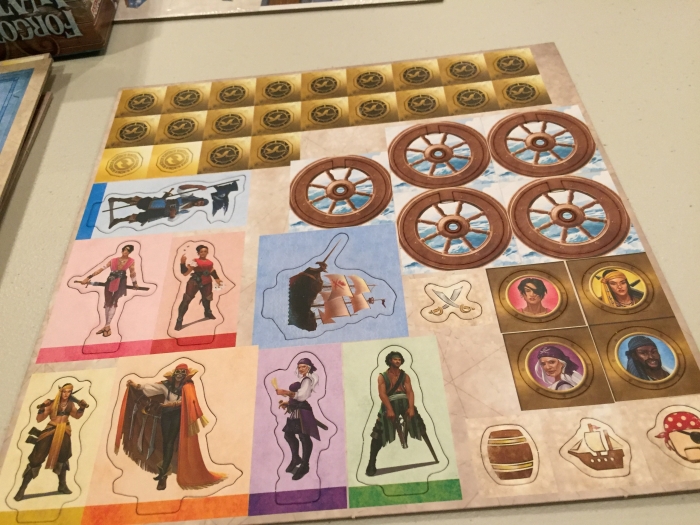Player Elimination
Many competitive games have abandoned Player Elimination as a mechanic for one simple reason: it’s not fun. I was reminded of this when we played a 6-Player version of King of New York and I was eliminated fairly quickly in the game. After being eliminated, I just sat there and watched the game. Whee … that was fun. I was reminded of all the fighting game like Risk or Diplomacy or Monopoly where you win by eliminating all other players. And I remember I hated being the eliminated player … watching and not playing.
Cooperative Games
/pic649329.jpg)
Here’s the thing: one of the reasons I was drawn to cooperative games is that they almost never have the Player Elimination mechanic. I am thinking of games like Defenders of the Realm, Pandemic, Codenames Duet, and many many more (!) where there’s not even any way to be eliminated. And it doesn’t seem like the mechanic is even missing: I am fighting monsters, but I don’t worry about dying!! I don’t miss it at all.
Hit Points or Limited Resources
I’m actually lying a little bit: these games have Player Elimination, it’s just that ALL players are eliminated at once and lose the game!!! Consider the losing rules for Defenders of the Realm:

If you look at Pandemic or Defenders of the Realm, you’ll notice there’s a losing condition if you “run out a global resource” (cards or disease cubes in Pandemic or minions or crystals in Defenders of the Realm). If you squint, it’s almost like they are “shared hit points” among all players: if all those “shared hit points” are gone, the players lose. Said another way, all players are eliminated at the same time!!

There are games (like The Master’s Trial: Wrath of Magmaroth, see above) where all cooperating players lose if just one of you dies! So, players have to make sure to keep everyone alive as during play! If just one of you dies, game over and you lose! Really, this is another way of preventing the grumpiness of Player Elimination: If any player is eliminated, the game is over so that the eliminated player doesn’t have to “suffer” through a continuing game where he is not playing.
This seems like a good thing: I disliked the Player Elimination mechanic and I was glad to see it was rarely an issue in cooperative games.
So why did I add it to Sidekick Saga?
Take It For the Team
/pic4583257.png)
Sidekick Saga is a cooperative superhero game for 1-4 players. As long as at least one Sidekick is still alive, the game continues. Any Sidekick who dies is:
- eliminated (in Dark Legacy mode) or
- continues in reduced utility (normal Legacy mode).
And the game still continues. Either way, the Sidekick who dies suffers the same problems seen in Player Elimination in Competitive Games!! Why on earth, after arguing earlier for hating this mechanic, would I add this back in?
/cdn.vox-cdn.com/uploads/chorus_asset/file/16326439/IMG_1884.jpg)
In a phrase, because death has meaning! If, as a superhero, I choose to “take it for the team” in the late game so that we can win, my death has meaning!!
The only way we could win was for Blackbird to run into the Ice-a-cane! His sacrifice made it so we could take down the Villain in the last turn! Without his sacrifice, we would have lost!
It is VERY thematic for a group of superheroes to continue after their compatriot has chosen to die to save the team: it’s what superheroes do!! They make the ultimate sacrifice!!
And there’s also the choice factor in the game: by removing the ability for the player to “take it for the team”, the game has fewer choices. By adding the ability to choose Player Elimination, players can choose to make the painful, tortured choice if they think they have no more options.
It’s a very human thing to do the right thing, to make the ultimate sacrifice for your group.
Other Games

Set A Watch is another game where play continues even if another player is “eliminated” (in this case, all players are exhausted). Players are given a choice of who will “exhaust an ability” card, and players may realize the only way to win is for Fred to completely exhaust himself so that the team’s remaining abilities can take out the bad guys. Like Sidekick Saga, it’s the choice that matters.

Marvel Champions is another game where players can continue even of their compatriots are eliminated. Very thematic for a superhero game!

Gloomhaven is another game where play continues even if other players are exhausted. Again, it’s the choice that matters.
Conclusion
In the last turn, Delphi appeared and made the ultimate sacrifice, taking all the damage from the Bad Guys. This left Epsilon Wave open to open the portal and banish the evil villain at the last minute … Delphi’s death was not in vain: only her sacrifice allowed Epsilon Wave to do what was needed.
At the end of the day, Player Elimination in a cooperative game can be useful and interesting as long as it is a choice and it has meaning. It’s when the elimination feels arbitrary (preventing you from playing after you are booted from the game) that Player Elimination is a undesirable mechanic.
Of course, you have to make sure you aren’t being bullied by an Alpha Player to make the ultimate sacrifice, but that’s a different issue …



















/pic5304567.jpg)


































/pic4820031.jpg)
/pic4161990.jpg)

/pic860217.jpg)
/pic4583266.png)
